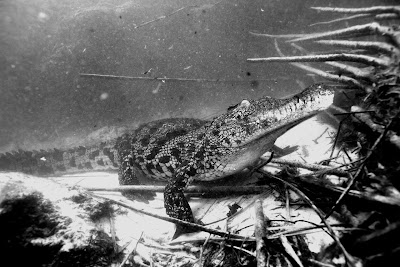Monday, September 17, 2012
A Wild Dog's Tale
Sunday, July 8, 2012
60 Minutes USA
Saturday, July 7, 2012
NHK Japan
Monday, June 18, 2012
Croc diving season 2012
Here is the link: http://sixtyminutes.ninemsn.com.au/article.aspx?id=8498686
 |
| Trying to get warm before diving on the coldest day of the year. |
 |
| Being glamorous for camera |
 |
| Dr Britton ready for action |
 |
| Richard being guinea pig in the comms masks |
 |
| Richard having survived the experience |
 | |||
| Team 60 Mins Australia |
Tuesday, January 24, 2012
At Abu

Earlier in 2011 Brad and I paid a whirlwind trip to Abu Camp, now run by Wilderness Safaris. The camp had just been revamped and was looking extremely fabulous. The last time I had been there was 8 years ago when I was pregnant (unknown to me) with Rio, so I was really looking forward to going back.
It was a working trip and very short, so we didn’t have much time to play or get the kids used to being around the eles as much as we would have liked to. Since our visit Wilderness Safaris (who have taken over the management of the camp) have done away with the usual protocol of chaining the elephants when in the boma. The transition has apparently gone very smoothly, putting many people’s minds at ease. There has also been another baby born to the herd since we were there. Definitely time to go back.
Monday, January 23, 2012
More crocodile stories
Also during croc season 2011 we had the privilege of guiding well-known Big Animal photographer Amos Nachoum and his rather colourful set of clients, amongst whom was John Abramo. He provided us with the most hysterically funny moment we have yet had underwater. This clip speaks for itself.
http://www.youtube.com/watch?v=o1ZAp4BhOys&noredirect=1
I suppose to the layman it is more terrifying than entertaining, and there is no doubt that John was terrified for a fleeting few moments, but this incident is made funny by the personalities involved and the build up to it. It happened towards the end of a long and entertaining week where John had consistently been the only diver who wasn’t jostling to get the close up picture. He was usually to happy to take a back seat, even on some occasions sitting out a dive or only getting in the water once the others had had their shot at it. He was content to sit on the boat and photograph birds rather than enter the fray.
On this day John was in the B team i.e waiting for the A-type A teamers to finish doing their thing. They had a great dive and were happy enough with the results to let the B team go ahead eventually. Once in the water the team had a fabulous few minutes with the crocodile before she decided to leave. As it happens, John was directly in her path.
To his credit he kept his camera firing until he could press the shutter no more (due to being completely squashed), and the results are spectacular. He is now the proud owner of truly astonishing pictures of crocodile belly scales and returned home with the closest of close-ups.
Needless to say the mirth on the boat continued for hours afterwards.
http://www.youtube.com/watch?v=tGDoUOWIbX8&feature=related
I must add that 99% of croc dives proceed without event. In fact this incident and the one mentioned in a previous post entitled “Swimming with Crocodiles” are the only ones we have ever had.
Another one of Amos’ clients was Daniel Botelho, a truly brilliant and inspirational photographer and general all round nice guy. (In fact the nicest guy - who also happens to have the nicest father - and I do realize that is a hell of a statement to make). Some of his pics from the trip are on his website www.danielbotelho.com
Amos, Brad and Daniel The Magnificent
Here is a link to some footage Brad took of Daniel face to face with a crocodile:
http://www.youtube.com/watch?v=elVlvQTW5MQ&feature=related













































